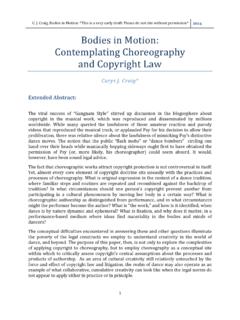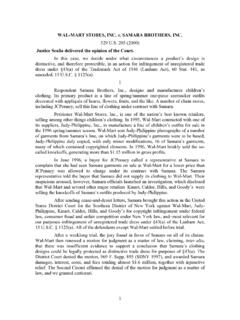Transcription of Outline for Wal-Mart Stores, Inc. v. Samara Brothers, Inc.
1 1 Outline for Wal-Mart stores , Inc. v. Samara Brothers, Inc. INTRODUCTION As a policy matter, the Supreme Court came to the correct result. This decision will likely promote both consumer interests and competition. The opinion does, however, demonstrate some doctrinal flaws. The Court did not explain how to distinguish between packaging and design, and the Court failed to reconcile Two Pesos and Wal-Mart . In the interest of promoting favorable precedent in trade dress law, the Court should have provided a test to distinguish between packaging and design. I. BACKGROUND A. The History of Trade Dress and the Lanham Act Includes discussion of the history of trade dress law Discussion of the Lanham Act B. Trade Dress Infringement and the Courts Approaches To Inherent Distinctiveness Discussion of the factors courts examine when considering trade dress infringement Discussion of the various inherent distinctiveness tests both before and after Two Pesos and the lower courts confusion over whether the trade dress mentioned in Two Pesos included packaging, design, or both II.
2 CASE SUMMARY A. The Facts B. The District Court Decision C. The Second Circuit Decision D. The Supreme Court Decision III. DISCUSSION A. From A Policy View, The Court Reached The Correct Overall Conclusion The Court reached the correct result as a policy matter, for two main reasons. First, Wal-Mart will likely benefit consumer s interests since it promotes competition in the marketplace. Second, Wal-Mart does not leave product designs unprotected, but instead requires proof of secondary meaning and encourages designers to seek protection under patent or copyright law 1. Promoting Competition and Consumer Interests 2oDiscussion of how the competitive interest in duplicating product designs is stronger than the interest in imitating packaging oDiscussion of how allowing trade dress protection of product designs may also frustrate competition by reducing an already limited supply product style options oDiscussion of how the Court furthered the interests of consumers and promoted competition oAs an alternative argument, Wal-Mart could possibly harm consumers who are interested in diversity in products rather than similarly designed knockoffs oEven if some design diversity is lost by limiting trade dress protection of designs, this fact only supports the view that there should be some form of product design protection and not that that form of protection should be trade dress law 2.
3 Design Patents, Copyrights, and Secondary Meaning oDiscussion of how Wal-Mart does not eliminate all trade dress protection for product designs, but rather encourages producers to develop secondary meaning in their designs or to turn to other methods of design protection oDiscussion of problems with other forms of protection available to designers oSuggestion that maybe another form of IP protection is necessary B. Doctrinal Problems with the Supreme Court s Decision Though the Court seems to have reached a correct decision from a policy standpoint, two main doctrinal problems are apparent in the Court s method of reaching its conclusion. First, the Court in Wal-Mart burdened lower courts with the task of distinguishing between packaging and design without explaining how this distinction should be made. Second, the Court failed to reconcile its seemingly conflicting Two Pesos opinion with its current reasoning in Wal-Mart . 1. Lack of Explanation for How to Distinguish Between Packaging and Design oThe Wal-Mart decision is beneficial in that the lower courts no longer have to consider the confusing issue of whether or not a product design is inherently distinctive created a more efficient bright-line rule oDiscussion of the problems with distinguishing between packaging and design and how the Court should have explained how to make this distinction oDiscussion of situations where it is very difficult to distinguish between packaging and design ( , restaurant d cor, Coca-Cola bottle) oTwo Pesos v.
4 Taco Cabana exhibits another example of packaging that could also be characterized as product design 3oThe Court provided no explanation of why Two Pesos involved packaging (why didn t the Court err on the side of product design as it directs the lower courts to do in the next paragraph?) 2. Failure to Reconcile Wal-Mart and Two Pesos oDiscussion of the conflicts between the two opinions oDiscussion of the differences in Lanham Act interpretation Two Pesos Court treated trademarks and trade dress the same since the Lanham did not say to treat them differently, but the Act doesn t say to treat design and packaging differently oDiscussion of the Court s changed definition of inherent distinctiveness C. What the Supreme Court Should Have Done Differently oThe Court should have strengthened its opinion from a doctrinal standpoint by resolving all of the problems considered in Section B oThe Court may have been able to resolve the packaging versus design issue by treating them both in the same manner V.
5 CONCLUSION In summary, though Wal-Mart may be disquieting for the lower courts considering product packaging and design issues, as a policy matter, the Court came to the correct result



















